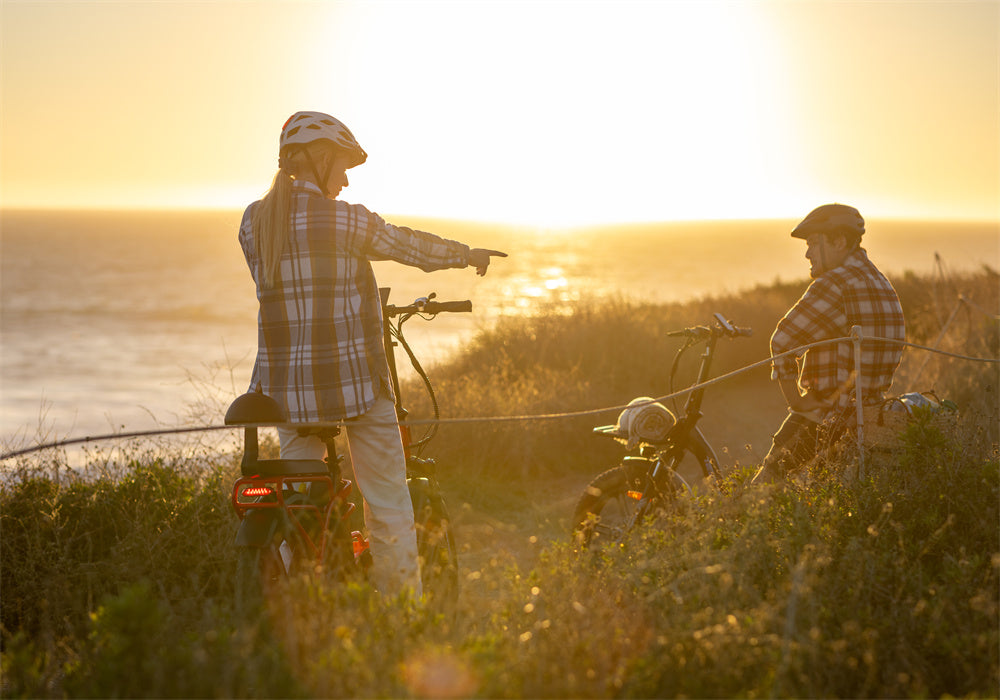The first "safe" bike called the "Rover," made in 1885 by a guy named John Kemp Starley. This bike was different because it had the same size wheels, a front wheel you could steer, and a chain that connected the pedals to the back wheel. This design became the blueprint for most bikes today.
Over time, bikes got better with the addition of gears. In the beginning, switching gears was tricky. Riders had to stop, get off the bike, and manually change the gears. One of the earliest ways to have two speeds on a bike was to have two different gears on each side of the back wheel. To switch gears, you had to take off the wheel, flip it around, and put it back on.
Gears help your bike move easier and faster. When you turn the pedals, gears change how hard or easy it is to ride. Gears are tools that make your bike feel lighter or heavier, depending on what you need. They make riding a bike more fun and less tiring, especially when you’re going up hills or riding on bumpy roads.

Types of Gears
Manual Gears: You have to switch them yourself using levers on the ebike. Manual gears give you more control over your ride. You decide when to make it easier or harder to pedal. Each click of the lever changes the gear, making your ride smoother or giving you more power when you need it.
Automatic Gears: These change by themselves. Automatic gears are great for beginners or people who don’t want to worry about shifting. The electric bike senses when you need to change gears and does it for you, so you can focus on enjoying your ride.
How Gears Work
When you pedal, the chain moves over gears, changing how much effort you need to pedal. Smaller gears make pedaling easier but slower, while bigger gears make pedaling harder but faster. Gears work by altering the mechanical advantage of the bike’s drivetrain.
This process involves changing the gear ratio, which determines how many times the rear wheel turns for each pedal stroke. In a lower gear, the chain is positioned on a smaller chainring at the front and a larger cog at the rear, making it easier to pedal but resulting in slower speeds. This is ideal for climbing hills or starting from a stop.
In a higher gear, the chain is on a larger chainring at the front and a smaller cog at the rear, making pedaling harder but increasing your speed. This is perfect for flat roads or downhill sections where you want to go faster with less pedaling.

How to Use Gear On A Bike
Starting Out
Start in a low gear. When you start riding, you want it to be easy to pedal, so you don’t get tired quickly. A low gear lets you get moving without much effort. Starting in a low gear is particularly important when you’re just beginning your ride or when you need to accelerate from a stop. This reduces the strain on your muscles and joints, allowing you to build up speed gradually.
As you gain momentum, you can shift to a higher gear to maintain a comfortable and efficient pedaling rhythm. The key to smooth gear shifting is to anticipate changes in terrain and adjust your gears accordingly. This means shifting to a lower gear before you start climbing a hill and shifting to a higher gear before you start descending.
By doing this, you can maintain a steady cadence and avoid sudden changes in effort, making your ride more enjoyable and less tiring.
Going Up a Hill
Switch to an easier gear. Shifting to a lower gear makes pedaling less strenuous. You’ll go slower, but it will be much easier to keep moving. Climbing a hill can be challenging, but using the right gear can make it more manageable. When you approach a hill, start shifting to a lower gear before you begin the climb.
This allows you to maintain a steady pedaling rhythm and avoid putting too much strain on your muscles. As you climb, continue to adjust your gears to find the most comfortable setting. It’s important to stay seated while climbing, as this helps maintain traction and balance.
Leaning slightly forward can also help keep your front wheel steady. Remember to breathe deeply and stay relaxed, as this can help you conserve energy and maintain a steady pace.
When choosing the best e-bike for tackling steep hills, consider TESWAY's line of folding electric bikes. The TESWAY X5 and TESWAY X7 are top choices for hill climbing. If your commute includes a hilly stretch, these two electric bicycles are your most suitable options.
Going Down a Hill
When you’re going downhill, you can switch to a higher gear to take advantage of the slope and go faster. Riding downhill can be exhilarating, but it’s important to stay in control.
Shifting to a higher gear allows you to maintain a comfortable pedaling rhythm without spinning your legs too fast. This helps you stay balanced and in control of your bike. When descending, keep your weight slightly back and your arms relaxed to absorb any bumps or shocks.
Look ahead to anticipate any obstacles or turns, and use your brakes gently to maintain a safe speed. Remember that even though you’re going downhill, it’s still important to pedal lightly to keep the chain engaged and the gears functioning smoothly.

Is It Harder to Ride a Bike Without Gears?
Yes, it can be! Riding a bike without gears means you have to use more energy to keep the bicycle moving, especially on hills or uneven paths. Gears help distribute your effort, making it easier to ride longer and enjoy the journey. Without gears, you’re limited to a single gear ratio, which might not be suitable for all terrains.
Climbing a steep hill without gears can be extremely tiring because you have to exert a lot of force to pedal. On the other hand, riding on flat terrain with a gear that’s too low can make you pedal too fast, which is inefficient and exhausting.
Gears provide the flexibility to adjust your pedaling effort according to the terrain, making your ride more comfortable and efficient. They allow you to maintain a steady cadence, which helps conserve energy and reduce muscle fatigue.

Good Gear Shifts vs. Bad Gear Shifts
A good gear shift happens smoothly and quietly. You should feel the gear change and notice a difference in how easy or hard it is to pedal. This kind of shift allows you to maintain a steady pedaling rhythm and make the most of your ebike’s capabilities.
A bad gear shift, on the other hand, might be noisy or feel jerky. If you hear grinding noises or the chain slips, it’s a sign that something is wrong. Bad shifts can cause wear and tear on your electric bike and make your ride uncomfortable.
To achieve a good shift, make sure you’re pedaling gently and steadily, and avoid shifting under too much pressure. Timing is also crucial for good shifting. Anticipate changes in terrain and shift gears before you need to, rather than waiting until the last minute. This prevents sudden changes in effort and keeps your ride smooth. If you experience bad shifts, check your electric bicycle for maintenance issues such as dirty or stretched cables, misaligned derailleur, or worn-out gears.

What to Do If a Jam Occurs During Gear Shift
If your gears jam while shifting, don’t panic. It’s usually easy to fix. Stop pedaling immediately to avoid damaging the gears or chain. Carefully examine the chain and gears to see if the chain is caught or stuck.
If the chain is off the gears, you can gently move the pedals backward to see if the chain releases. If that doesn’t work, you might need to get off the ebike and manually adjust the chain. Make sure the bike is on a stable surface and use a cloth or gloves to protect your hands. Gently lift the chain back onto the gears, making sure it’s properly aligned.
Once the chain is back in place, test the gears by pedaling gently and shifting through the gears. If the problem persists, it might be a sign of a deeper issue such as a bent derailleur or damaged gears. In this case, it’s best to take your bicycle to a professional for a thorough inspection and repair.

Top Tips for Smooth Gear Shifting
Pedal gently when shifting gears. Smooth and steady pedaling reduces the strain on your gears and chain, allowing for a more efficient and comfortable ride. Shift gears early when you see a hill coming. Anticipating changes in terrain helps you adjust your gears in advance, preventing sudden changes in effort and maintaining a steady pedaling rhythm.
Keep your bicycle’s chain and gears clean and well-oiled. Regular maintenance ensures that your gears and chain move smoothly, reducing friction and wear. A clean bike rides smoother and lasts longer. Practice makes perfect, so the more you ride and shift gears, the better you’ll get at it.
Developing a sense of when to shift gears and how to do it smoothly takes time and experience. Try practicing gear shifting in different scenarios, such as climbing hills, descending slopes, and riding on flat terrain. This will help you become more comfortable and confident in your shifting abilities.
Conclusion
Shifting gears on an electric bike is easy and fun when you know how. Gears make your ride smoother, easier, and more enjoyable. Ready to ride like a pro? Try shifting gears on your next bike ride and see the difference it makes. TESWAY best buy electric bicycles' gear have been developed to shift gears very smoothly, making your ride smoother and more enjoyable.







Share:
Get fit and burn calories effortlessly with e-bike rides
Keep Your Electric Bike Safe with These Essential Storage Tips